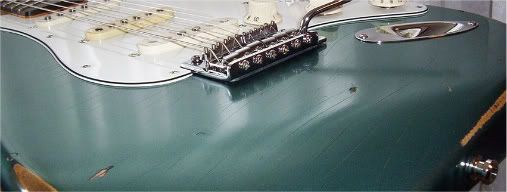Hi guys,
I recently replaced the strings on my Squier Affinity with a set with heavier gauge. Even after adjusting the bridge so that the springs are fully compressed, when I play the 12th fret, the string is still sharp when the open string is in tune. I tried lowering the action on my guitar but I was getting more string buzz. I'm just wondering what other options can I try, or whether I should switch back to the old string gauge.
Thanks
the 'Squier' marque includes a number of models: is this a Strat with a trem? (if so, you will need to tighten the trem springs -- under the cover, rear of body -- to return the bridge angle to proper position. heavier strings pull on the bridge/trem system with more force, typically tilting the bridge forward, causing the intonation issue you describe, as well as high action.)
not a Strat? then: what is the new gauge? all the strings or just some
-=tension & release=-
What gnease has said is true, as always, and an elevated tail at the end of a trem bridge will cause intonation problems, specifically that troublesome short fat E string, with sharpness. You probably have the traditional trem, and Squiers also have shortened side-to-side saddle measurements BTW, unless they are old and of Japanese origin, emulating Vintage Models, but yours is an Affinity. Anyhow, that doesn't affect intonation, it just places strings closer together, so you can't go to a really heavy gauge, like SRV's 13 - 53's, and sometimes bass strings. :lol:
Nevertheless, you should be able to use 10 - 46's if you want. Bring the tail end of the bridge down, as gnease instructs, tightening the springs at the claw in the rear trem cavity.
When you adjust the saddles, I note that you said the springs are fully compressed - that's how I read it. The 6th or E will be fairly compressed, often all the way, but the others are staggered, and in the normal pattern, it is safe to assume that the 3rd string is also wound, sitting taller in the saddle than a plain G, and that saddle will be be backed up as well.
I can show a picture of a bridge, on or off the body, strung or not, but will look for one showing the relationship to the body for you to judge if it will work for you. I built this, with the close-space, thinner saddle bridge, and made it floating. I am pretty picky, and action is low here, I see that I lowered the G saddle, while trying to follow the fret radius as well.
And FWIW, most techs and players avoid really low action because it also makes it harder to get the ball of your fretting fingers under the string, or in the middle of it, to bend up. So, lighter gauges with thinner strings are more bendable in the first place, and also if you enjoy lower action. Many techs say your finger rolls over and can't push a low, low string.
Like a bird on the wire,
like a drunk in a midnight choir
I have tried in my way to be free.
Hi guys,
I recently replaced the strings on my Squier Affinity with a set with heavier gauge. Even after adjusting the bridge so that the springs are fully compressed, when I play the 12th fret, the string is still sharp when the open string is in tune. I tried lowering the action on my guitar but I was getting more string buzz. I'm just wondering what other options can I try, or whether I should switch back to the old string gauge.
Thanks
Any followup - did you fix your set up and get new strings? :|
Like a bird on the wire,
like a drunk in a midnight choir
I have tried in my way to be free.


